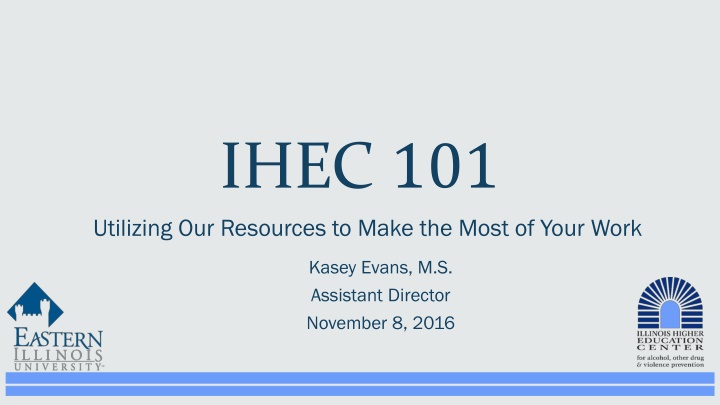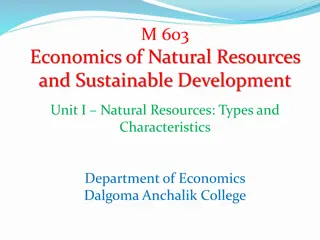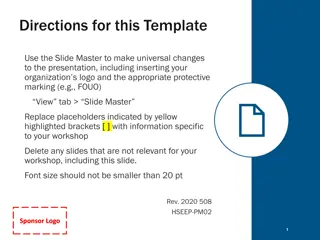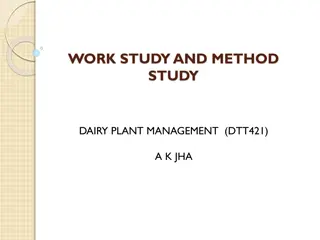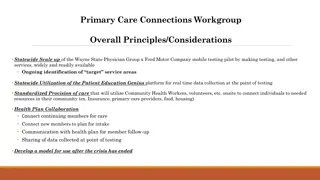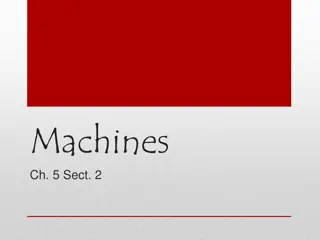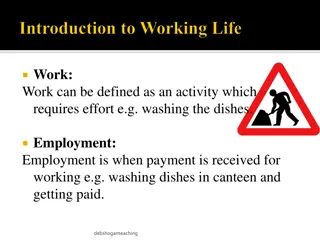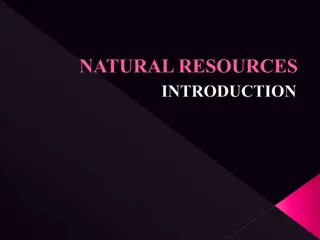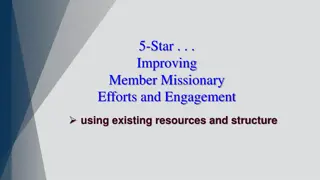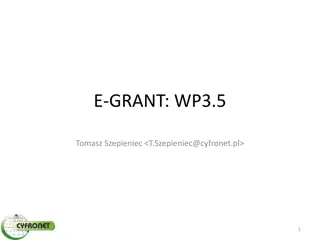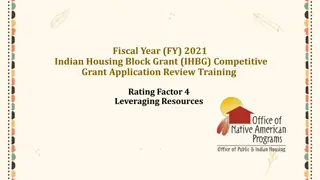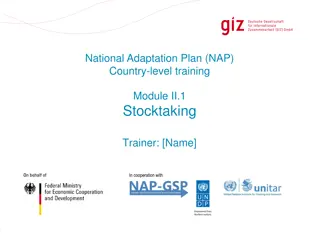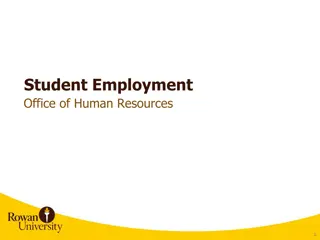Utilizing Resources for Effective Work
In this presentation, Kasey Evans discusses the state of higher education in Illinois, key alcohol statistics, and the Drug-Free Schools and Campuses Act. The focus is on maximizing resources for student well-being and academic success.
Download Presentation

Please find below an Image/Link to download the presentation.
The content on the website is provided AS IS for your information and personal use only. It may not be sold, licensed, or shared on other websites without obtaining consent from the author.If you encounter any issues during the download, it is possible that the publisher has removed the file from their server.
You are allowed to download the files provided on this website for personal or commercial use, subject to the condition that they are used lawfully. All files are the property of their respective owners.
The content on the website is provided AS IS for your information and personal use only. It may not be sold, licensed, or shared on other websites without obtaining consent from the author.
E N D
Presentation Transcript
IHEC 101 Utilizing Our Resources to Make the Most of Your Work Kasey Evans, M.S. Assistant Director November 8, 2016
The State of Higher Education within Illinois 49 2-Year Community Colleges 380,000 students, including cont. ed. or pre-collegiate. 12 Public 4-Year Institutions 205,000 students 99 Non-for Profit Institutions 231,000 students 25 For Profit Institutions 77,000 students 37 Out of State Institutions 9,000 students **Data based on Fall 2009 statistics from the Illinois Board of Higher Education**
Key Alcohol Statistics/Trends Following are some key findings on the use of Alcohol: 80.0 % of the students consumed alcohol in the past year ("annual prevalence"). 72.0% of all underage respondents reported consuming alcohol in the last 12 months 41.0 % of students reported binge drinking in the previous two weeks. A binge is defined as consuming 5 or more drinks in one sitting. The perceived mean number of alcohol consumed by the average student on a typical occasion stood at 5.5 drinks while the actual average number of drinks stood at 2.5 drinks per student on a typical occasion Following are some key findings on the use of tobacco and other drugs: 17.0 % of the students have used marijuana in the past year ("annual prevalence"). 24.0% of students reported using tobacco in the past year ( annual prevalence ). 3.00% of students reported cocaine use in the past year ( annual prevalence ). **According to the 2014 Illinois Core Report**
Drug Free Schools and Campuses Act EDGAR 86 Part 86, the Drug-Free Schools and Campuses Regulations, requires that, as a condition of receiving funds or any other form of as a condition of receiving funds or any other form of financial assistance under any federal program, an institution of financial assistance under any federal program, an institution of higher education (IHE) must certify that it has adopted and higher education (IHE) must certify that it has adopted and implemented a program to prevent the unlawful possession, use, or implemented a program to prevent the unlawful possession, use, or distribution of illicit drugs and alcohol by students and employees. distribution of illicit drugs and alcohol by students and employees.
Drug Free Schools and Campuses Act Minimum Requirements Annual notification/distribution of substance abuse policy and information to all students, staff and faculty. Development and implementation of a program to prevent the unlawful possession, use or distribution of illicit drugs or alcohol by students and and employees. Prepare a biennial report biennial report on the effectiveness of its alcohol and other drug (AOD) programs and the consistency of policy enforcement
The State of Prevention in Illinois IHE s Details regarding prevention efforts and funding in our state
Survey Administration Sent to 135 IHE s that were determined as target institutions Initially sent e-mail solicitations beginning in late March 2011 Sent reminder e-mails in mid-April, late April, and early May Utilized QuestionPro on-line survey program Survey had 120 views Survey had 78 surveys submitted 53 surveys completed (demographic variables answered)
Prevention Plan 45.5% have a formal ATOD Plan 30.3% have a prevention plan that is regularly reviewed 35.7% have priorities identified through data 26.8% have a plan with a timeline, listed tasks, goals and objectives
Prevention Staffing 66% of campuses have an individual whose responsibilities include overseeing ATOD programming and interventions Mean full time employee equivalent (FTE) spent on ATOD prevention was .23 FTE. the mean FTE for 4-year public institutions was 0.31 for 4-year private institutions was 0.27 FTE, for both community colleges and for-profit institutions, the mean FTE was 0.14.
Leading ATOD Programs/Activities/ Interventions Educational/Informational Handouts (69.9%) Alcohol Awareness Weeks (53.6%) Educational Workshops (50.0%) Health Fair (48.2%) Residence Halls Programs/Educationals (44.6%) Fatal Vision Goggle Programs (42.9%) Individualized Brief Assessment and Screening (39.3%)
Conclusions Most institutions answering survey were affiliated with IHEC reports are probably over exaggerated for state level generalization. Despite being called the #1 college public health and student development issue we re nowhere close to where we should be
Our Mission To assist Illinois colleges and universities in reducing the negative alcohol, other drug and violence consequences impeding student academic success, personal growth and development through policy development, education and student assistance, enforcement, assessment, campus/community collaboration and socio-ecological interventions.
Goals of IHEC To increase the number of Illinois colleges and universities having a campus/community coalition and/or a campus task force focusing on alcohol, other drug and violence prevention. To increase the number of Illinois institutions of higher education that collect and use data in their prevention efforts. To increase the number of campuses that use evidence-based prevention strategies. To increase the number of campuses using evaluation in their prevention efforts. To increase the number of campuses developing and implementing emerging policies based on evidence of effectiveness.
IHEC Funding IHEC is fully funded from the Illinois Department of Human Services, Bureau of Positive Youth Development. Our grant is through the Statewide Substance Abuse Prevention Program (SAPP)
SAPP Grant Activities CORE Alcohol and Drug Survey Quarterly Affiliate Meetings Professional Development/Continuing Education Trainings and Workshop Opportunities Professional Development/Continuing Education - Webinars Symposiums Drug Free Schools and Campuses Technical Assistance Biennial Review Report Reviews Communications and Social Media Collaboration with other State-Level Organizations Institutional Consultation Visits Toolkits Technical Assistance
CORE Alcohol and Drug Survey Conducted every 2 years - even years. Any IHE in Illinois can participate Recruitment materials are sent out in the Fall before the Survey year Schools are responsible for sending any additional questions to the CORE institute and for administering their survey. Surveys must be administered within the dates that IHEC establishes. Usually February through April.
CORE Alcohol and Drug Survey IHEC suggests that surveys be done BEFORE Spring break. After surveys are completed, IHEC pays for the surveys. Schools receive exec summary and dataset All of the data is added to the state data. A state report is completed and released during the odd year.
Advisory Meetings Quarterly Meetings Hosted throughout the state Afternoon presentations at each meeting. Networking opportunity! Resource Sharing
Continuing Education/Professional Development Trainings Webinars Past Statewide Conference Mini Conferences All of these opportunities can be found on our website.
Biennial Review Part 86, the Drug-Free Schools and Campuses Regulations, requires that, as a condition of receiving funds or any other form of as a condition of receiving funds or any other form of financial assistance under any federal program, an institution of financial assistance under any federal program, an institution of higher education (IHE) must certify that it has adopted and higher education (IHE) must certify that it has adopted and implemented a program to prevent the unlawful possession, use, or implemented a program to prevent the unlawful possession, use, or distribution of illicit drugs and alcohol by students and employees. distribution of illicit drugs and alcohol by students and employees. IHEC can review your Biennial Review OR help you write one! We IHEC can review your Biennial Review OR help you write one! We also have great resources on our website. also have great resources on our website.
Newsletters Monthly Newsletters through List Serve School spotlights Affiliate member spotlights Training information Conferences, webinars, etc. from outside agencies We are always accepting information!
Consultation Visits IHEC is available for a campus consultation visit. Consultation visits are tailored to each individual campus. Each campus will get a report based on the findings from the visit. Focus of the consultation visits: DFSCA Prevention Programming Approaches NIAAA College AIM (Alcohol Intervention Matrix) Your Alcohol and Other Drug Policy
Technical Assistance Any topic involving alcohol, other drug or violence prevention Website technical assistance form Email one of us! Call our office Come to a training/affiliate meeting!
IHEC Staff Eric S. Davidson, PhD Director esdavidson@eiu.edu Kasey Evans, MS Assistant Director kgevans@eiu.edu
Stay in Touch! Website: http://www.eiu.edu/ihec Email: ihec@eiu.edu Email us today to join our listserve!
